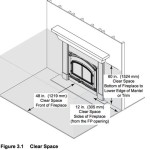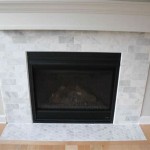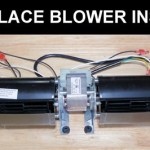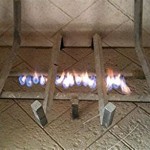Firerock Fireplace Inserts: A Comprehensive Overview
Firerock fireplace inserts represent a specific category of heating appliances designed to be installed within an existing masonry fireplace. These inserts offer a more efficient and controllable alternative to traditional open fireplaces, addressing concerns about energy waste and inconsistent heat output. This article will explore the functionality, benefits, selection criteria, installation considerations, and maintenance requirements associated with Firerock fireplace inserts.
Traditional open fireplaces, while aesthetically pleasing, are notoriously inefficient. A significant portion of the heat generated escapes up the chimney, leading to substantial energy loss and increased heating costs. Moreover, the radiant heat produced by an open fireplace tends to be unevenly distributed, creating hot and cold spots within a room. Firerock fireplace inserts aim to mitigate these issues by providing a closed combustion system and enhanced heat distribution capabilities.
Firerock, as a manufacturer, offers a range of fireplace inserts designed to accommodate various fireplace sizes and heating requirements. Their inserts typically feature a steel or cast-iron firebox, surrounded by decorative facing. The firebox is where combustion occurs, and its construction is critical for both efficiency and longevity. The facing, often made of materials like stone, brick, or metal, provides an aesthetic appeal that complements the surrounding décor. Importantly, Firerock does not publicly advertise nor sell direct to consumer.
Understanding the Functionality of Firerock Fireplace Inserts
The primary function of a Firerock fireplace insert is to provide efficient and controlled heating within an existing fireplace cavity. The insert operates as a closed combustion system, meaning that the air supply is regulated to optimize the burning process. This controlled combustion results in more complete burning of the fuel, whether it be wood, gas, or propane, leading to higher heat output and reduced emissions.
Unlike an open fireplace, which draws air from the room and exhausts it up the chimney, a Firerock fireplace insert typically draws combustion air from outside the house via a dedicated air intake. This eliminates the need to draw heated air from the room, further enhancing efficiency. The exhaust gases are vented through a stainless-steel liner that runs up the chimney, ensuring safe and proper venting of combustion byproducts.
Firerock fireplace inserts often incorporate a blower system to circulate heated air into the room. The blower draws air from around the firebox and forces it through vents on the front of the insert, distributing the heat more evenly throughout the living space. The blower speed is usually adjustable, allowing the user to control the heat output and circulation as needed. This forced-air circulation is a significant advantage over the radiant heat of an open fireplace, which tends to concentrate heat in a limited area.
Many Firerock fireplace inserts also offer thermostatic control, allowing the user to set a desired room temperature. The insert will automatically adjust its heat output to maintain the set temperature, providing consistent and comfortable heating. This feature is particularly useful for maintaining a steady temperature overnight or when the user is away from home.
Key Benefits of Choosing Firerock Fireplace Inserts
The advantages of installing a Firerock fireplace insert are multifaceted, encompassing energy efficiency, improved heating performance, enhanced safety, and aesthetic appeal. Compared to traditional open fireplaces, inserts offer a significant improvement in overall heating effectiveness.
Energy Efficiency: Firerock fireplace inserts are significantly more energy-efficient than open fireplaces. The closed combustion system and controlled air intake minimize heat loss, resulting in lower fuel consumption and reduced heating costs. The use of a stainless-steel chimney liner also helps to prevent heat loss through the chimney.
Improved Heating Performance: The combination of controlled combustion and forced-air circulation provides more consistent and even heating compared to the radiant heat of an open fireplace. The adjustable blower speed and thermostatic control allow the user to customize the heat output to their specific needs and preferences.
Enhanced Safety: Firerock fireplace inserts offer improved safety compared to open fireplaces. The closed combustion system reduces the risk of sparks and embers escaping into the room. The stainless-steel chimney liner helps to prevent chimney fires by containing and safely venting combustion byproducts. Many inserts also feature safety features such as overheat protection and automatic shut-off.
Aesthetic Appeal: Firerock offers a variety of facing options to complement different décor styles. The insert can be customized to match the existing fireplace surround or to create a new focal point in the room. The clean lines and modern designs of many Firerock inserts can enhance the aesthetic appeal of any living space.
Reduce Carbon Monoxide Risk: Properly installed and maintained Firerock inserts, when used with appropriate venting and fuel, significantly reduce the risk of carbon monoxide poisoning compared to improperly functioning or unvented heating appliances. The closed combustion system and dedicated flue liner ensure that combustion gases are safely vented outside the home.
Factors to Consider When Selecting a Firerock Fireplace Insert
Choosing the right Firerock fireplace insert requires careful consideration of several factors, including the fireplace size, heating requirements, fuel type preference, and aesthetic preferences. A thorough assessment of these factors will help ensure that the selected insert meets the specific needs and expectations of the homeowner.
Fireplace Size: The dimensions of the existing fireplace opening are a critical factor in determining the appropriate size insert. The insert must fit comfortably within the fireplace cavity, with sufficient clearance for proper ventilation. Careful measurement of the fireplace opening is essential before selecting an insert. Firerock provides detailed specifications for each of their inserts, including the required fireplace opening dimensions.
Heating Requirements: The square footage of the area to be heated is another important consideration. Firerock fireplace inserts are rated by their heat output in BTUs (British Thermal Units). The appropriate BTU rating will depend on the size of the room, the insulation level, and the climate. A larger room or a poorly insulated home will require a higher BTU rating. Consulting with a qualified dealer or installer can help determine the appropriate BTU rating for specific needs. It's important to consider the primary use case: supplemental heating versus primary source.
Fuel Type: Firerock fireplace inserts are available in wood-burning, gas, and propane models. The choice of fuel type will depend on factors such as fuel availability, cost, and personal preferences. Wood-burning inserts offer a traditional aesthetic and the potential for lower fuel costs, but require more maintenance and create more emissions. Gas and propane inserts offer convenience and clean burning, but may have higher fuel costs. The existing gas line or propane tank setup must also be considered.
Aesthetic Preferences: Firerock offers a variety of facing options to complement different décor styles. Homeowners should consider their personal preferences and the existing décor of the room when selecting a facing style. Options may include stone, brick, metal, and various color and texture choices. The facing can significantly impact the overall aesthetic appeal of the insert and the surrounding space.
Efficiency Rating: It's important to review the Energy Efficiency rating on the inserts. A higher rating translate to less fuel consumption for similar heat output.
Budget: The overall cost, including the unit, installation, and future maintenance, must be considered. While a more expensive unit might have higher energy efficiency, the price must be justified with usage cases. Professional installation is often required or highly recommended and that adds to the overall project cost.
Installation and Maintenance Considerations
Proper installation and maintenance are essential for ensuring the safe and efficient operation of a Firerock fireplace insert. Incorrect installation can lead to safety hazards, such as carbon monoxide leaks or chimney fires. Regular maintenance will help to prolong the life of the insert and maintain its performance.
Professional Installation: It is strongly recommended that Firerock fireplace inserts be installed by a qualified professional. A professional installer will have the necessary knowledge and experience to ensure that the insert is installed correctly and safely. Installation typically involves connecting the insert to a stainless-steel chimney liner, ensuring proper ventilation, and connecting the gas or propane supply if applicable. The installer will also ensure that the insert meets all applicable building codes and safety regulations.
Chimney Liner Installation: The installation of a stainless-steel chimney liner is a critical aspect of a Firerock fireplace insert installation. The liner provides a dedicated and safe pathway for the exhaust gases to escape the house. The liner must be properly sized and installed to prevent creosote buildup and ensure proper draft. A professional installer will be able to determine the appropriate liner size and installation method.
Regular Cleaning: Regular cleaning is essential for maintaining the efficiency and safety of a Firerock fireplace insert. Wood-burning inserts should be cleaned regularly to remove ash and creosote buildup. Gas and propane inserts should be inspected annually for any signs of damage or wear. The glass door should be cleaned regularly to maintain visibility of the flames. Cleaning should follow the manufacturer's guidelines.
Annual Inspections: Annual inspections by a qualified professional are recommended to ensure that the insert is operating safely and efficiently. The inspector will check for any signs of damage, wear, or malfunction. The inspector will also check the chimney liner for any cracks or leaks. Any necessary repairs or maintenance should be performed promptly.
Proper Fuel Storage: When using a wood-burning insert, proper storage of firewood is essential. Firewood should be stored in a dry, covered area to prevent moisture buildup. Wet firewood will burn inefficiently and produce more creosote. It is also important to avoid storing firewood too close to the insert, as this can create a fire hazard.
In conclusion, Firerock fireplace inserts offer a compelling alternative to traditional fireplaces, providing enhanced efficiency, improved heat distribution, and increased safety. Careful consideration of factors such as fireplace size, heating requirements, fuel type preference, and aesthetic preferences is crucial in selecting the most suitable insert. Professional installation and regular maintenance are essential for ensuring long-term performance and safe operation.

Pre Engineered Arched Masonry Wood Burning Outdoor Fireplace 30 Woodland Direct

Firerock Kits Versa Lok Midwest

Firerock Outdoor Kits Bellstone

Firerock Vent Free Kits Bellstone

42 In Firerock Arched Masonry Outdoor Wood Burning Fireplace Kits Patio

114j 30 Straight Outdoor Fireplace Alabama Whole Stone

Firerock Fireplaces South Alabama Brick Company

42 In Firerock Arched Masonry Outdoor Wood Burning Fireplace Patio Backyard

Firerock Fireplaces South Alabama Brick Company

Firerock Kits Versa Lok Midwest
Related Posts








